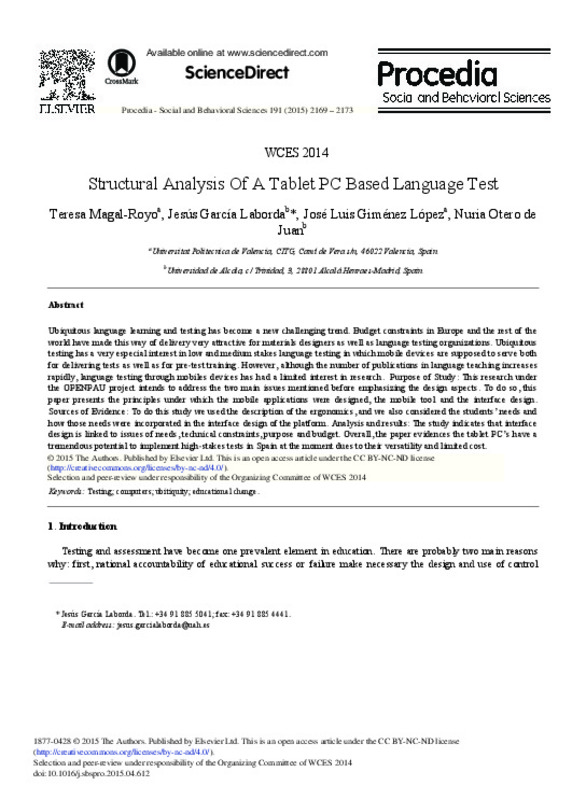JavaScript is disabled for your browser. Some features of this site may not work without it.
Buscar en RiuNet
Listar
Mi cuenta
Estadísticas
Ayuda RiuNet
Admin. UPV
Structural Analysis of a Tablet PC Based Language Test
Mostrar el registro sencillo del ítem
Ficheros en el ítem
| dc.contributor.author | Magal Royo, Teresa
|
es_ES |
| dc.contributor.author | García Laborda, Jesús
|
es_ES |
| dc.contributor.author | Giménez López, José Luis
|
es_ES |
| dc.contributor.author | Otero de Juan, Nuria
|
es_ES |
| dc.date.accessioned | 2018-04-14T04:14:43Z | |
| dc.date.available | 2018-04-14T04:14:43Z | |
| dc.date.issued | 2015 | es_ES |
| dc.identifier.issn | 1877-0428 | es_ES |
| dc.identifier.uri | http://hdl.handle.net/10251/100409 | |
| dc.description.abstract | [EN] Ubiquitous language learning and testing has become a new challenging trend. Budget constraints in Europe and the rest of the world have made this way of delivery very attractive for materials designers as well as language testing organizations. Ubiquitoustesting has a very especial interest in low and medium stakes language testing in which mobile devices are supposed to serve both for delivering tests as well as for pre-test training. However, although the number of publications in language teaching increases rapidly, language testing through mobiles devices has had a limited interest in research. Purpose of Study: This research under the OPENPAU project intends to address the two main issues mentioned before emphasizing the design aspects. To do so, this paper presents the principles under which the mobile applications were designed, the mobile tool and the interface design. Sources of Evidence: To do this study we used the description of the ergonomics, and we also considered the students needs and how those needs were incorporated in the interface design of the platform. Analysis and results: The study indicates that interface design is linked to issues of needs, technical constraints, purpose and budget. Overall, the paper evidences the tablet PC s have a tremendous potential to implement high-stakes tests in Spain at the moment dues to their versatility and limited cost. | es_ES |
| dc.language | Inglés | es_ES |
| dc.publisher | Elsevier | es_ES |
| dc.relation.ispartof | Procedia - Social and Behavioral Sciences | es_ES |
| dc.rights | Reconocimiento - No comercial - Sin obra derivada (by-nc-nd) | es_ES |
| dc.subject | Testing | es_ES |
| dc.subject | Computers | es_ES |
| dc.subject | Ubitiquity | es_ES |
| dc.subject | Educational change | es_ES |
| dc.subject.classification | EXPRESION GRAFICA EN LA INGENIERIA | es_ES |
| dc.subject.classification | FILOLOGIA INGLESA | es_ES |
| dc.title | Structural Analysis of a Tablet PC Based Language Test | es_ES |
| dc.type | Artículo | es_ES |
| dc.identifier.doi | 10.1016/j.sbspro.2015.04.612 | es_ES |
| dc.rights.accessRights | Abierto | es_ES |
| dc.contributor.affiliation | Universitat Politècnica de València. Departamento de Lingüística Aplicada - Departament de Lingüística Aplicada | es_ES |
| dc.contributor.affiliation | Universitat Politècnica de València. Departamento de Ingeniería Gráfica - Departament d'Enginyeria Gràfica | es_ES |
| dc.description.accrualMethod | S | es_ES |
| dc.relation.publisherversion | https://doi.org/10.1016/j.sbspro.2015.04.612 | es_ES |
| dc.description.upvformatpinicio | 2169 | es_ES |
| dc.description.upvformatpfin | 2173 | es_ES |
| dc.type.version | info:eu-repo/semantics/publishedVersion | es_ES |
| dc.description.volume | 191 | es_ES |
| dc.relation.pasarela | S\298675 | es_ES |








